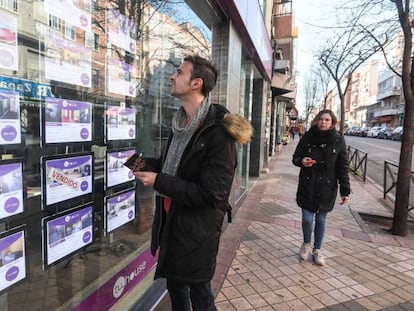What is causing the steady exodus of children from downtown Madrid?
Families with kids continue to abandon the heart of the capital as prices rise along with tourist numbers
- 0.1
- 0.8
- 1
- 3
- 6
Children for every 10 adults according to the census
When the weekend is over in the Madrid neighborhood of Malasaña, small children pour like fairies out onto the street, as though they had been waiting for the end of a storm. It is 8am and sidewalks that had been crawling with young adults enjoying themselves in ‘the cradle of La Movida’ are now the stamping ground for small feet heading to the Pi y Margall elementary school.
At times, the police patrol the entrance to the school, which is housed in a former convent on a corner of Plaza Dos de Mayo, a square famous for its botellón – illegal but tolerated street gatherings involving large quantities of alcohol bought from local shops.
Everywhere on display are posters emblazoned with SOS Malasaña, a neighborhood campaign against the transformation of the area into a theme park and a tourism hub. The warnings say that local residents are “in danger of extinction.”
Since 2003, the percentage of children under five has fallen from 3.6% to 2.8%
The campaign is a cry for help. And it is echoed in other areas of Madrid’s city center, which is gradually losing its children, according to an investigation by EL PAÍS. Since 2003, the percentage of children under the age of five has fallen from 3.6% to 2.8% according to the Centro district census, which has a total of 132,352 registered residents. In 2011, the number of children under five fell below 5,000 for the first time this century, and currently stands at 3,844.
The decline is not due to the drop in the national birth rate. In fact, there are approximately the same number of children now as there were in 2003 in Madrid, both in absolute terms and as a percentage of the population. In 2011, they made up 4.9% of the total population; today they account for 4.2%. But the center is home to very few of them.
This is largely because the heart of the city has been appropriated by adults between the ages of 25 and 39. The residents never get older, nor do they have children, suggesting that couples starting families simply move away, to be replaced by the next generation of young adults without kids.
The Pi y Margall school principal, Teresa Aira, says it is common for parents to come and tell her that they are moving in the middle of the school year because their landlords have raised their rent. But many keep their children at the school even after leaving. “People really love this school,” she says.
In general, public schools are few and far between in the city center, and invariably used to have a waiting list. “There were parents who couldn’t get a spot for their children 30 years ago,” says Saturnino Vera, president of the Cavas La Latina neighborhood association. Now, schools hold open door days to attract new students.
We want a statute that protects us, similar to the one that protects the Iberian lynx or the grizzly bear Jordi Gordon, SOS Malasaña activist
But according to SOS Malasaña and other residents’ associations, the exodus of parents with children has more to do with the feverish commercialization of their neighborhoods. “The city is a place to live, not to do business with,” says Jordi Gordon, SOS Malasaña activist.
This commercialization is leading to a range of problems, including the proliferation of properties used by tourist accommodation websites like Airbnb, evictions of residents who are unable to assume the frequent hikes in rent, and the shutting of local stores to make way for more bars and restaurants.
Long-term residents blame the demographic crisis on the authorities, which have been giving priority to tourists for what seems like far too long. “We want a statute that protects us, similar to the one that protects the Iberian lynx or the grizzly bear,” says Gordon.
The flight from the center is a trend that is also on display in other European cities and in the US, where the media cites rising rent as the main cause.
During the walk to school, families pass street cleaners dealing with the fallout from the previous night’s festivities. It is nothing new. This area has long been associated with noise and filth. In fact, there were worse times in the past, such as during the heroin epidemic of the 1980s, but at least then Malasaña had an identity as a neighborhood, something that is sorely missed.
There are of course advantages to living in the city center; while thousands of other Madrileños are stuck in traffic jams, Teresa de las Cuevas, a 40-year-old nurse, walks to school with her two children in five minutes. And the new Madrid Central traffic restrictions mean she barely has to stop for cars. Living downtown also gives her easy access to culture and entertainment. “It’s a personal choice,” she says.
Naturally, it is culture and entertainment that attract the younger adults. “If you are single, Malasaña is a great neighborhood because you’ve got partying, theater, late-night bars – you’ve got it all,” says Miguel Parrondo, a father at the Pi y Margall elementary school.
According to residents' associations, the exodus of parents with children has to do with the feverish commercialization of neighborhoods
The problem is that these young singles are in transit, and generally move on when they reach the next stage in their lives, detracting from any long-term community feel. Many choose alternative areas of the city to bring up their children, such as Hortaleza, El Goloso and Valverde in the north, and Arganzuela and Villa de Vallecas in the south.
Carolina Madruga and her wife Rocío Rodríguez left their apartment near the Plaza de Cascorro two years ago, when they made the decision to become parents. “We couldn’t picture ourselves with a child there for a number of reasons,” says Madruga, 34. “But we made the move when they put the rent up for Airbnb.” The couple now lives in the district of Hortaleza, in the northeast of the capital.
Many families are finding that the tourist boom has turned the center into something of a circus. In 2018, Madrid had a record 10.2 million visitors and it is likely that this figure will continue to grow.
The floating population in the center’s 5.2 square kilometers – an area just slight smaller than Gibraltar – makes it the most densely populated part of the city. According to municipal figures, the floating population in Sol, for example, is 178% of the resident population, while the floating population in the Cortes neighborhood is 116% of the resident population.
No room to grow
If international tourism was merely symbolic in the middle of the 20th century, with just 25 million trips, by 2012 there were more than a billion international trips, and the World Tourism Organization predicts that this figure will rise beyond 1.8 billion by 2030.
Critics of the touristification of Madrid believe that authorities have still not come up with an integral plan to make the industry sustainable, while the measures they do take appear peppered with contradictions. For example, the traffic and Airbnb restrictions make the center more livable, but the competition to attract ever greater numbers of visitors continues apace, according to Pedro Bravo, author of the book Excess Baggage. “Madrid and other cities are constantly vying to outshine one another and attract business, talent, tourism and investment,” he says.
Critics feel measures like a tax on tourism, tourist quotas and the return to social housing projects would make city centers more resident-friendly. In some cities, drastic measures have been adopted such as an almost complete ban on Airbnb – in Mallorca and Miami Beach – and a referendum on expropriating housing owned by large companies, a measure being considered in Berlin.

Before the local elections in May, Madrid authorities are planning to ban the conversion of homes for tertiary uses, which would have an impact on hotels and Airbnb apartments. It will also establish a minimum distance between bars and cafés, which, according to district councilor Jorge García Castaño, will make granting new licenses in the center practically impossible. Castaño would also like to adopt stricter measures such as a tourist tax, but that would require a change to regional legislation.
Madrid’s director of tourism, Miguel Sanz, believes the capital could still take in more tourists, but the flow needs to be directed to other areas of the city such as the Bernabéu soccer stadium or the Manzanares river area. “We want the Madrid for tourists to look more like the real Madrid,” says Sanz.
Meanwhile, for some residents, the measures are too little, too late. “People are moving out but it doesn’t matter how much you say it, the authorities don’t see it,” says Vera, the president of las Cavas La Latina neighborhood association.
Cristina Sánchez, 40, had enough three years ago, and now lives in Hoyo de Manzanares, in the mountain area north of the city, with her partner Rolando Fernández and their three-year-old daughter. “The city center is no place for a family,” she says. “I never imagined being a mother without being close to nature, and now I wouldn’t go back.”
English version by Heather Galloway.

